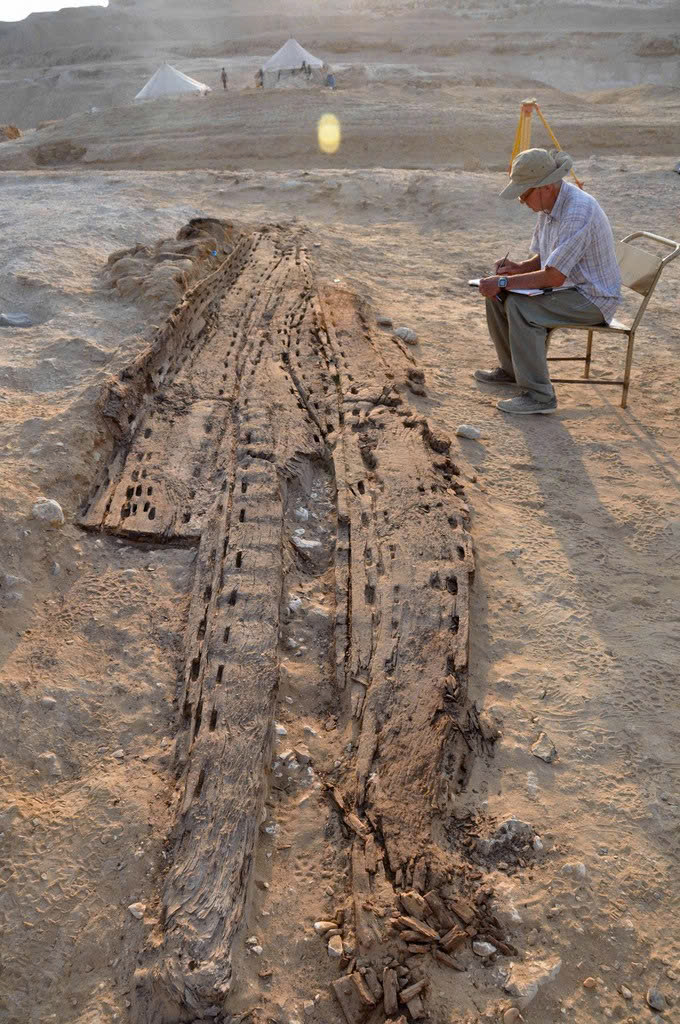In the arid expanse of the desert northwest of Cairo, the French Institute of Oriental Archaeology has uncovered a breathtaking archaeological treasure that provides a rare glimpse into the ancient Egyptian civilization. This extraordinary discovery—a nearly intact solar boat dating back to the reign of Pharaoh Den—offers profound insights into the spiritual and technological achievements of Egypt’s First Dynasty, a period marked by significant cultural and societal development.

A Symbolic Vessel of Ancient Beliefs
Stretching 20 feet in length and five feet in width, the solar boat is a marvel of ancient craftsmanship. It was meticulously constructed from 11 carefully chosen planks of locally sourced wood, astonishingly preserved by the desert’s dry, unforgiving climate. However, this is no ordinary boat. Solar boats held deep spiritual significance in ancient Egyptian cosmology. They were not designed for travel on earthly waters but for a far more celestial purpose. According to ancient beliefs, these vessels carried the souls of pharaohs through the heavens, enabling them to accompany the sun god Ra on his eternal journey across the sky. This belief underscored the Egyptian worldview, where life, death, and the afterlife were intricately interconnected.
The Archaeological Significance of Abu Rawash
The site of Abu Rawash, where this remarkable find was unearthed, has long been regarded as a site of immense historical importance. This area, known for its burial grounds and ruins, has yielded countless artifacts that have enriched our understanding of ancient Egypt’s formative years. The discovery of this solar boat adds yet another layer to the historical narrative, shedding light on the spiritual beliefs and advanced technical capabilities of a civilization at the very dawn of recorded history.
Pharaoh Den, whose reign is linked to this boat, was one of the prominent rulers of Egypt’s First Dynasty. His era marked significant developments in statecraft, religious practices, and technological innovation. The boat’s discovery offers tangible evidence of the sophistication of early Egyptian society, particularly in areas such as craftsmanship, engineering, and spiritual practices.
More Than Just an Artifact
This solar boat transcends its physical form as an artifact; it represents a tangible link to a world that existed nearly 5,000 years ago. The excavation team is now engaged in a meticulous study of the vessel, focusing on its construction techniques and the materials used. The planks of wood, likely harvested from the Nile Valley or nearby regions, reveal the Egyptians’ ability to work with natural resources to create durable and intricate structures. Researchers are also analyzing tool marks and joinery methods, providing valuable insights into the advanced shipbuilding techniques of the era.
These studies are critical to understanding not only the boat itself but also the broader funerary customs of the time. Solar boats were often placed in tombs or burial sites as part of the elaborate funerary rituals practiced by ancient Egyptians. These rituals, deeply rooted in their spiritual beliefs, aimed to ensure safe passage for the deceased into the afterlife. The boat, therefore, serves as a testament to the Egyptians’ profound focus on preparing for eternity.
Unlocking History Through Preservation
The preservation of this solar boat is a testament to the unique conditions of Egypt’s desert sands, which have served as nature’s archive for millennia. These sands have safeguarded countless relics of the past, allowing modern archaeologists to uncover and study the remnants of one of history’s most influential civilizations. Each discovery, like this boat, brings us closer to understanding the complexities of ancient Egyptian life, from their religious practices to their technological achievements.
Preserving such artifacts is not merely about maintaining physical objects; it is about preserving the whispers of history. Each plank, joint, and detail of this solar boat carries with it a story of ingenuity, belief, and the human desire to transcend mortality. These are stories that would remain untold without the dedicated efforts of archaeologists and researchers who bring these ancient treasures to light.
A Legacy of Innovation and Spirituality
As the research on this remarkable solar boat continues, it promises to contribute significantly to our understanding of ancient Egyptian culture. This vessel, built with such care and precision, speaks to the technological prowess of a civilization that thrived thousands of years ago. Its spiritual significance highlights the depth of the Egyptians’ belief system, where the material and the metaphysical were seamlessly intertwined.
The discovery also reminds us of the enduring legacy of ancient Egypt. Despite the passage of millennia, the culture’s achievements in art, architecture, and technology continue to captivate and inspire. The solar boat stands as a symbol of this legacy, a tangible reminder of a civilization that left an indelible mark on human history.
Bridging Past and Present
Perhaps most profoundly, this solar boat serves as a bridge between the past and the present. It invites us to reflect on the ingenuity and spirituality of a civilization that, despite existing thousands of years ago, shares a deep connection with modern humanity’s quest for meaning and understanding. The boat’s story is not just about the ancient Egyptians but about the timeless human desire to explore, innovate, and seek answers to life’s greatest mysteries.
In the sands of Abu Rawash, history has once again revealed itself in a way that is both humbling and awe-inspiring. This solar boat, with its sacred purpose and intricate craftsmanship, is more than an artifact—it is a messenger from the past, reminding us of the incredible achievements of ancient Egypt. As researchers continue their work, this discovery promises to deepen our appreciation for a civilization that shaped the course of human history, leaving behind a legacy that endures to this day.





